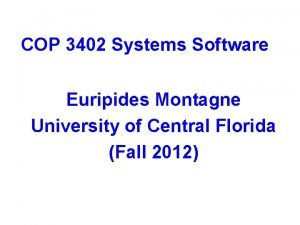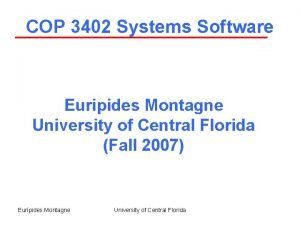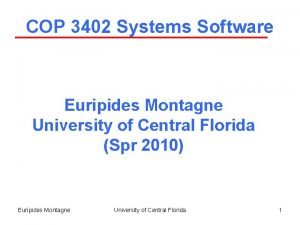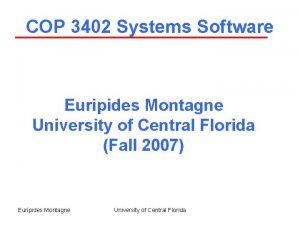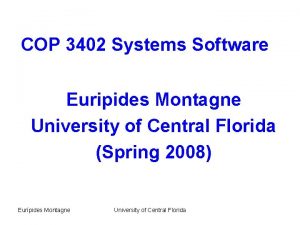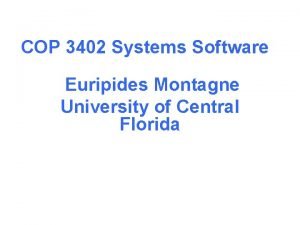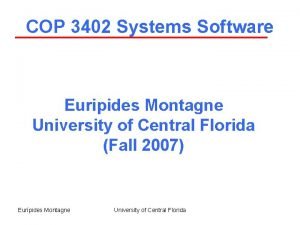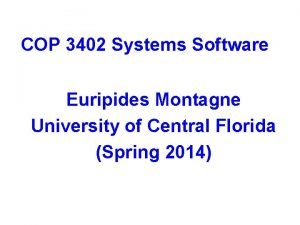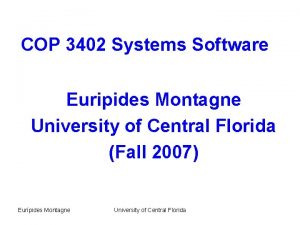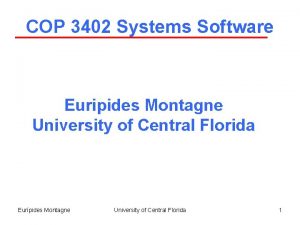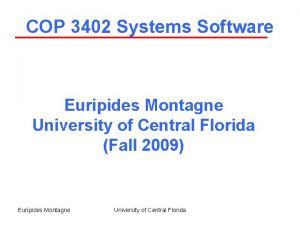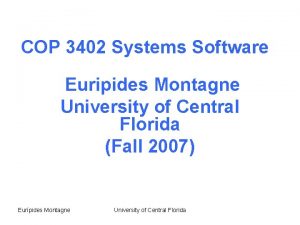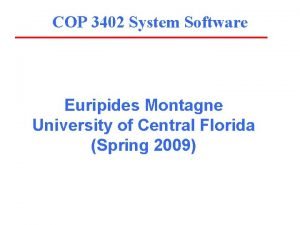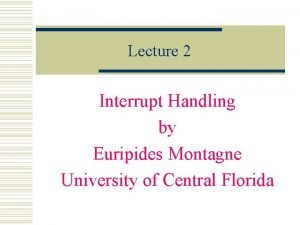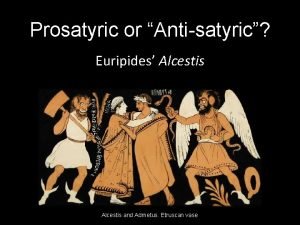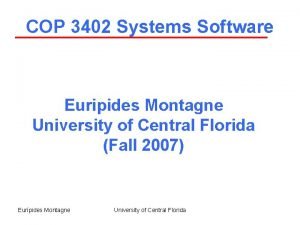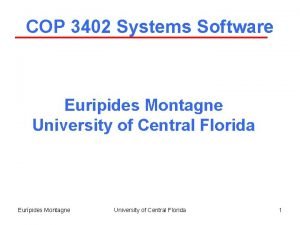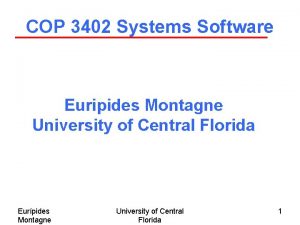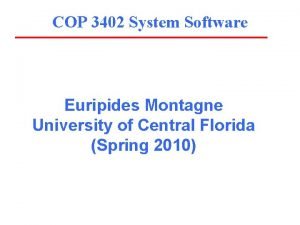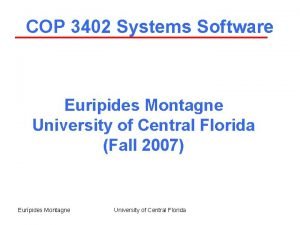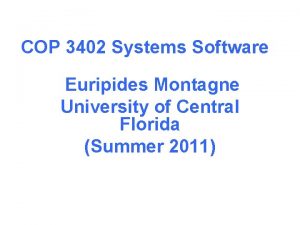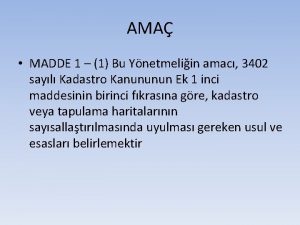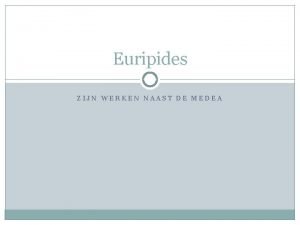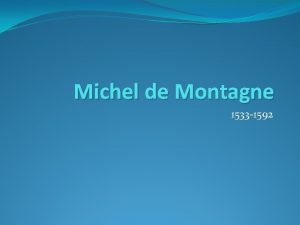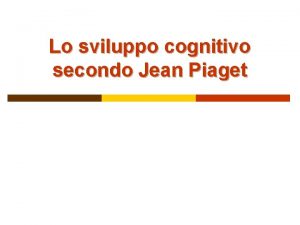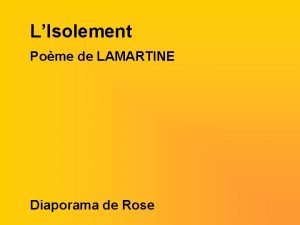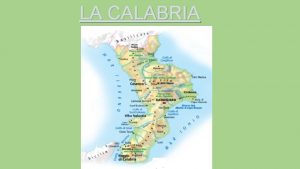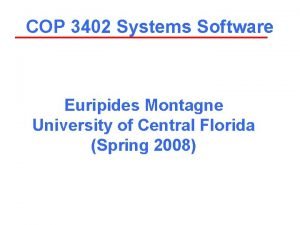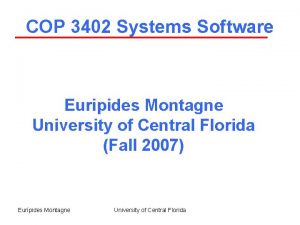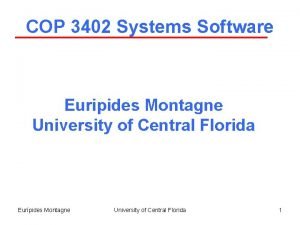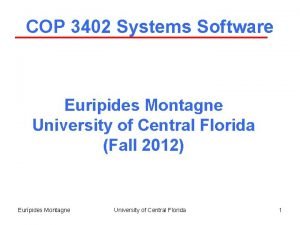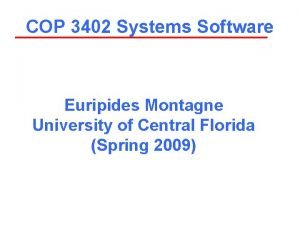COP 3402 Systems Software Euripides Montagne University of

















![00 Fetch Cycle 1. MAR PC 2. MDR MEM[MAR] 3. IR MDR 4. PC 00 Fetch Cycle 1. MAR PC 2. MDR MEM[MAR] 3. IR MDR 4. PC](https://slidetodoc.com/presentation_image/2ab21d8112c33a793a19a5aa8a2c9387/image-18.jpg)
![Execution: 01 LOAD 1. 2. 3. 4. MAR IR. ADDR MEM[MAR] A MDR DECODER Execution: 01 LOAD 1. 2. 3. 4. MAR IR. ADDR MEM[MAR] A MDR DECODER](https://slidetodoc.com/presentation_image/2ab21d8112c33a793a19a5aa8a2c9387/image-19.jpg)
![Execution: 02 ADD 1. 2. 3. 4. MAR IR. ADDR MEM[MAR] A A + Execution: 02 ADD 1. 2. 3. 4. MAR IR. ADDR MEM[MAR] A A +](https://slidetodoc.com/presentation_image/2ab21d8112c33a793a19a5aa8a2c9387/image-20.jpg)
![Execution: 03 STORE 1. 2. 3. 4. MAR IR. ADDR MDR A MEM[MAR] MDR Execution: 03 STORE 1. 2. 3. 4. MAR IR. ADDR MDR A MEM[MAR] MDR](https://slidetodoc.com/presentation_image/2ab21d8112c33a793a19a5aa8a2c9387/image-21.jpg)

![Instruction Set Architecture (ISA) 00 Fetch (hidden instruction) MAR PC MDR MEM[MAR] IR MDR Instruction Set Architecture (ISA) 00 Fetch (hidden instruction) MAR PC MDR MEM[MAR] IR MDR](https://slidetodoc.com/presentation_image/2ab21d8112c33a793a19a5aa8a2c9387/image-23.jpg)



















- Slides: 42

COP 3402 Systems Software Euripides Montagne University of Central Florida

COP 3402 Systems Software The processor as an instruction interpreter. Eurípides Montagne University of Central Florida 2

Outline 1. The structure of a tiny computer. 2. A program as an isolated system. 3. The instruction format. 4. Assembly language. Eurípides Montagne University of Central Florida 3

Von-Neumann Machine (VN) PC MAR MEMORY IR OP ADDRESS MDR A Decoder ALU Eurípides Montagne University of Central Florida 4

Instruction Cycle • The Instruction Cycle, or Machine Cycle, in the Von-Neumann Machine (VN) is composed of 2 steps: • 1. Fetch Cycle: Instruction is retrieved from memory. • 2. Execution Cycle: Instruction is executed. • A simple Hardware Description Language will be used in order to understand how instructions are executed in VN. Eurípides Montagne University of Central Florida 5

Definitions • Program Counter (PC) is a register that holds the address of the next instruction to be executed. • Memory Address Register (MAR) is a register used to store the address to a specific memory location in Main Storage so that data can be written to or read from that location. • Main Storage (MEM) is used to store programs and data. Random Access Memory (RAM) is a implementation of MEM. Eurípides Montagne University of Central Florida 6

Definitions • Memory Data Register (MDR) is a register used to store data that is being sent to or received from the MEM. The data that it stores can either be in the form of instructions or simple data such as an integer. • Instruction Register (IR) is a register that stores the instruction to be executed by the processor. Eurípides Montagne University of Central Florida 7

Definition • Arithmetic Logic Unit (ALU) is used to execute mathematical instructions such as ADD or SUB. • DECODER is a circuit that decides which instruction the processor will execute. For example, It takes the instruction op-code from the IR as input and outputs a signal to the ALU to control the execution of the ADD instruction. • Accumulator (A) is used to store data to be used as input to the ALU. Eurípides Montagne University of Central Florida 8

Fetch-Execute Cycle • In the VN, the Instruction Cycle is defined by the following loop: Fetch Execute • In order to fully explain the Fetch Cycle we need to study the details of the VN data flow. The data flow consists of 4 steps. Eurípides Montagne University of Central Florida 9

Data Movement 1 • Given registers PC and MAR, the transfer of the contents of PC into MAR is indicated as: MAR PC PC MAR MEMORY OP ADDRESS MDR A Decoder ALU Eurípides Montagne University of Central Florida 10

Data Movement 2 • To transfer information from a memory location to the register MDR, we use: PC MAR MEMORY(MEM) MEM[MAR] MDR MEM[MAR] • The address of the memory location has been stored previously into the MAR register Eurípides Montagne OP ADDRESS MDR A Decoder University of Central Florida ALU 11

Data Movement 2 (Cont. ) • To transfer information from the MDR register to a memory location, we use: MEM [MAR] MDR *see previous slide for diagram • The address of the memory location has been previously stored into the MAR Eurípides Montagne University of Central Florida 12

Data Movement 3 • Transferring the contents of MDR into IR is indicated as: IR MDR PC MAR MEMORY OP ADDRESS MDR A Decoder ALU Eurípides Montagne University of Central Florida 13

Instruction Register Properties • The Instruction Register (IR) has two fields: Operation (OP) and the ADDRESS. • These fields can be accessed using the selector operator “. ” Eurípides Montagne University of Central Florida 14

Data Movement 4 • The Operation portion of the field is accessed as IR. OP • The operation field of the IR register is sent out to the DECODER using: DECODER IR. OP • DECODER: If the value of IR. OP==00, then the decoder can be set to execute the fetch cycle again. Eurípides Montagne University of Central Florida 15

Data Movement 4 Cont. DECODER IR. OP PC MAR MEMORY OP ADDRESS MDR A Decoder ALU Eurípides Montagne University of Central Florida 16

Instruction Cycle • The Instruction Cycle has 2 components. • Fetch Cycle which retrieves the instruction from memory. • Execution Cycle which carries out the execution of the instruction retrieved. Eurípides Montagne University of Central Florida 17
![00 Fetch Cycle 1 MAR PC 2 MDR MEMMAR 3 IR MDR 4 PC 00 Fetch Cycle 1. MAR PC 2. MDR MEM[MAR] 3. IR MDR 4. PC](https://slidetodoc.com/presentation_image/2ab21d8112c33a793a19a5aa8a2c9387/image-18.jpg)
00 Fetch Cycle 1. MAR PC 2. MDR MEM[MAR] 3. IR MDR 4. PC PC+1 5. DECODER IR. OP Eurípides Montagne 1. Copy contents of PC into MAR 2. Load content of memory location into MDR 3. Copy value stored in MDR to IR 4. Increment PC Register University of Central Florida 18
![Execution 01 LOAD 1 2 3 4 MAR IR ADDR MEMMAR A MDR DECODER Execution: 01 LOAD 1. 2. 3. 4. MAR IR. ADDR MEM[MAR] A MDR DECODER](https://slidetodoc.com/presentation_image/2ab21d8112c33a793a19a5aa8a2c9387/image-19.jpg)
Execution: 01 LOAD 1. 2. 3. 4. MAR IR. ADDR MEM[MAR] A MDR DECODER 00 Eurípides Montagne 1. Copy the IR address value field into MAR 2. Load the content of a memory location into MDR 3. Copy content of MDR into A register 4. Set Decoder to execute Fetch Cycle University of Central Florida 19
![Execution 02 ADD 1 2 3 4 MAR IR ADDR MEMMAR A A Execution: 02 ADD 1. 2. 3. 4. MAR IR. ADDR MEM[MAR] A A +](https://slidetodoc.com/presentation_image/2ab21d8112c33a793a19a5aa8a2c9387/image-20.jpg)
Execution: 02 ADD 1. 2. 3. 4. MAR IR. ADDR MEM[MAR] A A + MDR DECODER 00 Eurípides Montagne 1. Copy the IR address value field into MAR 2. Load content of memory location to MDR 3. Add contents of MDR and A register and store result into A 4. Set Decoder to execute Fetch cycle University of Central Florida 20
![Execution 03 STORE 1 2 3 4 MAR IR ADDR MDR A MEMMAR MDR Execution: 03 STORE 1. 2. 3. 4. MAR IR. ADDR MDR A MEM[MAR] MDR](https://slidetodoc.com/presentation_image/2ab21d8112c33a793a19a5aa8a2c9387/image-21.jpg)
Execution: 03 STORE 1. 2. 3. 4. MAR IR. ADDR MDR A MEM[MAR] MDR DECODER 00 Eurípides Montagne 1. Copy the IR address value field into MAR 2. Copy A register contents into MDR 3. Copy content of MDR into a memory location 4. Set Decoder to execute fetch cycle University of Central Florida 21

Execution: 07 HALT 1. STOP Eurípides Montagne 1. Program ends normally University of Central Florida 22
![Instruction Set Architecture ISA 00 Fetch hidden instruction MAR PC MDR MEMMAR IR MDR Instruction Set Architecture (ISA) 00 Fetch (hidden instruction) MAR PC MDR MEM[MAR] IR MDR](https://slidetodoc.com/presentation_image/2ab21d8112c33a793a19a5aa8a2c9387/image-23.jpg)
Instruction Set Architecture (ISA) 00 Fetch (hidden instruction) MAR PC MDR MEM[MAR] IR MDR PC PC+1 DECODER IR. OP 02 Add MAR IR. Address MDR MEM[MAR] A A + MDR DECODER 00 Eurípides Montagne 01 Load MAR IR. Address MDR MEM[MAR] A MDR DECODER 00 03 Store MAR IR. Address MDR A MEM[MAR] MDR DECODER 00 07 Halt University of Central Florida 23

One Address Architecture (instruction format) • The instruction format of this one-address architecture is: OP LOAD Eurípides Montagne ADDRESS 0000 0010 University of Central Florida 24

Instruction Set Architecture • 01 - LOAD <X> Loads the contents of memory location “X” into the A (A stands for Accumulator). • 02 - ADD <X> The data value stored at address “X” is added to the A and the result is stored back in the A. • 03 - STORE <X> Store the contents of the A into memory location “X”. • 04 - SUB <X> Subtracts the value located at address “X” from the A and stored the result back in the A. Eurípides Montagne University of Central Florida 25

Instruction Set Architecture • 05 - IN <Device #> A value from the input device is transferred into the AC. • 06 - OUT <Device #> Print out the contents of the AC in the output device. • Device # 5 7 9 Device Keyboard Printer Screen For instance you can write: 003 IN <5> “ 23” where “ 23” is the value you are typing in. Eurípides Montagne University of Central Florida 26

Instruction Set Architecture • 07 - Halt The machine stops execution of the program. (Return to the O. S) • 08 - JMP <X> Causes an unconditional branch to address “X”. PC X • 09 - SKIPZ If the contents of Z flag = 1 the next instruction is skipped. (If the output of the ALU equals zero, the Z flag is set to 1. In this machine, it means Accumulator = 0) Eurípides Montagne University of Central Florida 27

If the output of the ALU equals zero, the Z flag is set to 1 PC MAR MEMORY Z =Condition Code OP ADDRESS MDR A 0 Decoder ALU A=0 Z Eurípides Montagne University of Central Florida 28

Instruction Set Architecture • For this tiny assembly language, we are using only one condition code (CC) Z = 0. • Condition codes indicate the result of the most recent arithmetic operation • Two more flags (CC) can be incorporated to test negative and positives values: G = 1 Positive value Z = 1 Zero L = 1 Negative value Eurípides Montagne University of Central Florida 29

Program State Word (condition codes - CC) The PSW is a register in the CPU that provides the OS with information on the status of the running program Interrupt Flags PC MASK CC Mode OV MP PI TI I/O SVC To be defined later G Z L In addition to the Z flag, we can incorporate two more flags: 1) G meaning “greater than zero” 2) L meaning “less than zero” Eurípides Montagne University of Central Florida 30

ISA Instruction descriptions opcode mnemonic meaning 0001 0010 0011 0100 0101 0110 0111 1000 1001 1010 1011 LOAD <x> ADD <x> STORE <x> SUB <x> IN <Device_#> OUT <Device_#> HALT JMP <x> SKIPZ SKIPG SKIPL A Mem[x] A A + Mem[x] A A A – Mem[x] A read from Device A output to Device Stop PC x If Z = 1 Skip next instruction If G = 1 Skip next instruction If L = 1 Skip next instruction Eurípides Montagne University of Central Florida 31

Assembly language Programming examples Assign a memory location to each variable: C X + Y; <000> <001> <002> If it is necessary to use temporary memory locations, assign labels (names) to them. Eurípides Montagne University of Central Florida 32

Assembly language Programming examples Memory 000 1245 001 1755 002 0000 After execution 003 Load <000> 004 Add <001> 005 Store <002> 006 Halt Eurípides Montagne University of Central Florida Memory 000 1245 001 1755 002 3000 003 Load <000> 004 Add <001> 005 Store <002> 006 Halt 33

One Address Architecture • The instruction format of this one-address architecture consists of 16 bits: 4 bits to represent instructions and 12 bits for addresses : OP 0001 Eurípides Montagne ADDRESS 0000 0001 University of Central Florida 34

Assembler: translate symbolic code to executable code (binary) Assembly Language 003 Load <000> 004 Add <001> 005 Store <002> 006 Halt Assembler Eurípides Montagne 01 LOAD 02 ADD 03 STORE 04 SUB 05 IN 003 004 005 006 06 OUT 07 HALT 08 JMP 09 SKIPZ In binary 0001 0000 0010 0000 0001 0011 00000010 0111 0000000 University of Central Florida 35

Assembler Directives • The next step to improve our assembly language is the incorporation of pseudo-ops (assembler directives) to invoke a special service from the assembler (pseudo-operations do not generate code). begin tell the assembler where the program starts . data to reserve a memory location and give an initial value. . end tells the assembler where the program ends. Labels are symbolic names used to identify memory locations. Eurípides Montagne University of Central Florida 36

Assembler Directives This is an example of the usage of assembler directives. begin “Assembly language instructions” halt (return to OS). data (to reserve a memory location and give initial values). end ( tells the assembler where the program ends) note: the directive. end can be used to indicate where the program starts (for example: “. end <insert label here>” Eurípides Montagne University of Central Florida 37

Assembly language Programming examples Label start a b TWO in store load sub add out halt. data. end Eurípides Montagne opcode address. begin x 005 a x 005 b a TWO b x 009 0 0. data start Text section (code) Data section 2 University of Central Florida 38

LOAD/STORE ARCHITECTURE A load/store architecture has a “register file” in the CPU and it uses three instruction formats. Therefore, its assembly language is different to the one of the accumulator machine. ADDRESS OP OP Ri JMP <address> ADDRESS Rj Rk Load R 3, <address> Add R 3, R 2, R 1

Load/Store Architecture PC INPUT/OUT MAR MEMORY R 0 OP R 1 R 2 R 3 MDR Decoder + Eurípides Montagne University of Central Florida ALU 40

Multiplying two numbers Label start here a b ONE result opcode address. begin in store load add store load sub store skipz jmp load out halt. data. end x 005 a x 005 b result a result b ONE b Label start here result x 009 0 0 1. data start 0 a b ONE result opcode address. begin in store load add sub skipz jmp store load out halt. data. end x 005 R 0, a x 005 R 0, b R 2, result R 3, a R 0, b R 1, ONE R 2, R 3 R 0, R 1 here R 2, result R 0, result x 009 0 0 1. data start 0 One address Architecture Load/Store architecture Eurípides Montagne University of Central Florida 41

Next time will talk about Lecture 2 virtual machines
 Euripides montagne
Euripides montagne Euripides montagne
Euripides montagne Cop 3402
Cop 3402 Euripides montagne
Euripides montagne Euripides montagne
Euripides montagne Euripides montagne
Euripides montagne Euripides montagne
Euripides montagne Euripides montagne
Euripides montagne Euripides montagne
Euripides montagne Euripides montagne
Euripides montagne Euripides montagne
Euripides montagne Euripides montagne
Euripides montagne Cop 3402
Cop 3402 Euripides montagne
Euripides montagne Euripides montagne
Euripides montagne Syntax graph
Syntax graph Euripides montagne
Euripides montagne Euripides montagne
Euripides montagne Cop 3402
Cop 3402 Euripides montagne
Euripides montagne Cop 3402
Cop 3402 Cop 3402
Cop 3402 Good cop bad cop interrogation
Good cop bad cop interrogation Cop 1 cop 2
Cop 1 cop 2 Sas 70 isae 3402
Sas 70 isae 3402 3402 1 madde
3402 1 madde Euripides werken
Euripides werken Medea euripides analyse
Medea euripides analyse Eschilo, sofocle euripide differenze
Eschilo, sofocle euripide differenze Dans un coin perdu de montagne
Dans un coin perdu de montagne Origine tettonica montagne
Origine tettonica montagne Michel de montagne
Michel de montagne Compito delle tre montagne
Compito delle tre montagne Souvent sur la montagne
Souvent sur la montagne Jojo productions
Jojo productions Pourquoi gilbert montagné se balance-t-il lorsqu'il chante
Pourquoi gilbert montagné se balance-t-il lorsqu'il chante Suc et sentenac centre de vacances
Suc et sentenac centre de vacances Les yeux bleus de la montagne
Les yeux bleus de la montagne Cartina della calabria politica
Cartina della calabria politica Aiguille montagne pelée
Aiguille montagne pelée Montagne boy
Montagne boy Loi montagne 2016
Loi montagne 2016 Montagne sens figuré
Montagne sens figuré
